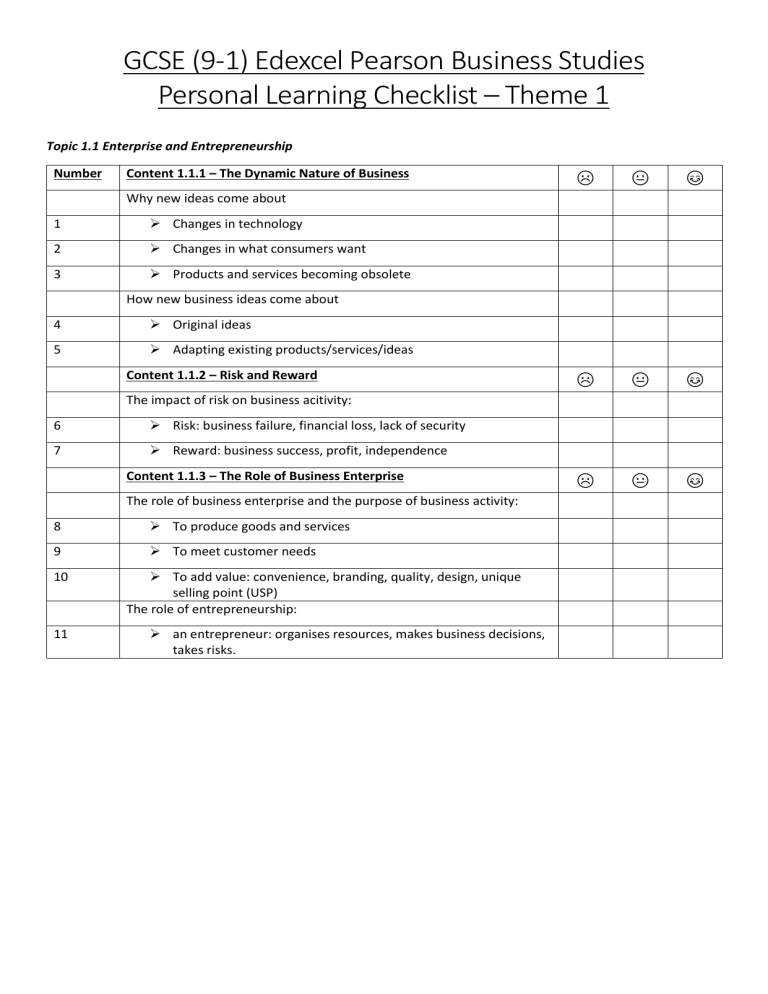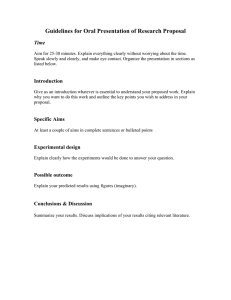
GCSE (9-1) Edexcel Pearson Business Studies Personal Learning Checklist – Theme 1 Topic 1.1 Enterprise and Entrepreneurship Number Content 1.1.1 – The Dynamic Nature of Business ☹ 😐 😊 ☹ 😐 😊 ☹ 😐 😊 Why new ideas come about 1 Changes in technology 2 Changes in what consumers want 3 Products and services becoming obsolete How new business ideas come about 4 Original ideas 5 Adapting existing products/services/ideas Content 1.1.2 – Risk and Reward The impact of risk on business acitivity: 6 Risk: business failure, financial loss, lack of security 7 Reward: business success, profit, independence Content 1.1.3 – The Role of Business Enterprise The role of business enterprise and the purpose of business activity: 8 To produce goods and services 9 To meet customer needs 10 11 To add value: convenience, branding, quality, design, unique selling point (USP) The role of entrepreneurship: an entrepreneur: organises resources, makes business decisions, takes risks. Topic 1.2 Spotting a Business Opportunity Number Content 1.2.1 - Customer needs ☹ 😐 😊 ☹ 😐 😊 ☹ 😐 😊 ☹ 😐 😊 Identifying and understanding customer needs: 12 13 what customer needs are: price, quality, choice, convenience the importance of identifying and understanding customers: generating sales, business survival. Content 1.2.2 - Market Research The purpose of market research: 14 to identify and understand customer needs 15 to identify gaps in the market 16 to reduce risk 17 to inform business decisions. Methods of market research: 18 19 primary research: survey, questionnaire, focus group, observation secondary research: internet, market reports, government reports. The use of data in market research: 20 qualitative and quantitative data 21 the role of social media in collecting market research data 22 the importance of the reliability of market research data. Content 1.2.3 - Market Segmentation How businesses use market segmentation to target customers: 23 identifying market segments: location, demographics, lifestyle, income, age market mapping to identify a gap in the market and the competition. Content 1.2.4 - The Competitive Environment Understanding the competitive environment: 24 strengths and weaknesses of competitors based on: price, quality, location, product range and customer service 25 the impact of competition on business decision making Topic 1.3 Putting a Business Idea into Practice Number Content 1.3.1 - Business Aims and Objectives 26 What business aims and objectives are. ☹ 😐 😊 ☹ 😐 😊 ☹ 😐 😊 ☹ 😐 😊 Business aims and objectives when starting up: 27 28 29 financial aims and objectives: survival, profit, sales, market share, financial security non-financial aims and objectives: social objectives, personal satisfaction, challenge, independence and control. Why aims and objectives differ between businesses. Content 1.3.2 - Business Revenues, Costs and Profits The concept and calculation of: 30 Revenue 31 Fixed and variable costs 32 Total costs 33 Profit and loss 34 Interest 35 Break-even level of output 36 Margin of Safety Interpretation of break-even diagrams: 37 The impact of changes in revenue and costs 38 Break-even level of output 39 Margin of safety 40 Profit and loss Content 1.3.3 - Cash and Cash Flow The importance of cash to a business: 41 To pay suppliers, overheads and employees 42 To prevent business failure (insolvency) 43 The difference between cash and profit Calculation and interpretation of cash-flow forecasts: 44 Cash inflows 45 Cash outflow 46 Net cash flow 47 Opening and closing balances Content 1.3.4 - Sources of Business Finance Sources of finance for a start-up or established small business: 48 49 Short-term sources: overdraft and trade credit Long-term sources: personal savings, venture capital, share capital, loans, retained profit and crowd funding. Topic 1.4 Making the Business Effective Number Content 1.4.1 - The options for start-up and small business ☹ 😐 😊 ☹ 😐 😊 ☹ 😐 😊 ☹ 😐 😊 The concept of limited liability: 50 51 limited and unlimited liability the implications for the business owner(s) of limited and unlimited liability The types of business ownership for start-ups (definitions): 52 Sole Trader, Partnership, Private Limited Company (Ltd) 53 Franchise The advantages and disadvantages for each business ownership: 54 Sole Trader 55 Partnership 56 Private limited company (Ltd) 57 Franchise Content 1.4.2 - Business Location Factors influencing business location: 58 Proximity to: market, labour, materials and competitors 59 Nature of business activity 60 Impact of the internet on location decisions: e-commerce and/or fixed premises Content 1.4.3 - The Marketing Mix What the marketing mix is and the importance of each element: 61 Price 62 Product 63 Place 64 Promotion How the elements of the marketing mix work together: 65 66 67 68 69 Balancing the marketing mix based on the competitive environment The impact of the changing consumer needs on the marketing mix The impact of technology on the marketing mix (e-commerce, digital communication) Content 1.4.4 - Business Plans The role and importance of a business plan: Identify the business idea; Business aims and objectives; Target market (market research); Forecast revenue, cost and profit; Cash-flow forecast; Sources of finance; Location; Marketing mix. The role and importance of a business plan in minimising risk and obtaining finance Topic 1.5 Understanding external influences on business Number Content 1.5.1 - Business Stakeholders ☹ 😐 😊 ☹ 😐 😊 ☹ 😐 😊 ☹ 😐 😊 ☹ 😐 😊 Who business stakeholders are and their objectives: 70 Shareholders (owners), employees, customers, managers, suppliers, local community, pressure groups, the government. Stakeholders and businesses: 71 How stakeholders are affected by business activity 72 How stakeholders impact business activity 73 Possible conflicts between stakeholder groups Content 1.5.2 - Technology and Business Different types of technology used by business: 74 E-commerce 75 Social media 76 Digital communication 76 Payment systems How technology influences business activity in terms of: 78 Sales 79 Costs 80 Marketing mix Content 1.5.3 - Legislation and Business 81 82 83 The purpose of legislation: Principles of consumer law: quality and consumer rights Principles of employment law: recruitment, pay, discrimination and health & safety The impact of legislation on businesses: 84 Cost 85 Consequences of meeting and not meeting these obligations Content 1.5.4 - The Economy and Business The impact of the economic climate on businesses: 86 Unemployment, changing levels of consumer income, inflation, changes in interest rates, government taxation, changes in exchange rates Content 1.5.5 - External Influences The importance of external influences on business: 87 Possible responses by the business to changes in technology, legislation, the economic climate.


